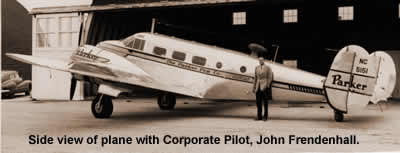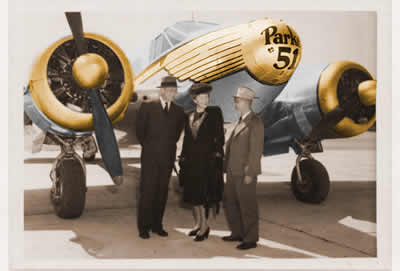
March 6, 1946 The Janesville
Daily Gazette
"Parker Buys $65,000. Plane" A new post-war
model low-wing monoplane, purchased by the Parker Pen Co. has
just been flown to the Rock County Airport by John Fendenhall,
company pilot.
The sleek new silver twin-engine Beechcraft D18S, serial # A-113
came off the assembly line just this week, replacing a smaller
five-passenger Cessna aircraft. The plane is to be stored in
a new hanger built especially for the Parker Pen Co. "
This Beechcraft airplane is believed to have inspired Kenneth
Parker to produce what is known as the first of the Flighter
series of fountain pens. This accompanying vintage photo shows the stunning deco pattern
golden wings trailing off the nose of the plane and the engine
cowlings, golden Parker "arrows" decorate each side
of the fuselage. This design and decoration was not actually
completed until 1948. Here you now see the very first Parker
Flighter.
This accompanying vintage photo shows the stunning deco pattern
golden wings trailing off the nose of the plane and the engine
cowlings, golden Parker "arrows" decorate each side
of the fuselage. This design and decoration was not actually
completed until 1948. Here you now see the very first Parker
Flighter.
You can see how easily Mr. Parker became captivated by this
modern silver aluminum and golden design. Four years later
the Flighter pen would be introduced.
Note the registration number ("N" number) on the
wing. The NC prefix, "N" being the U.S. designator,and
"C" standing for Civil. Kenneth Parker was determined
and had a great desire for this vanity number, and it is believed
that many Parker "51" pen sets found their way from
Parker executives to FAA officials in the process of their
application for this designation. The first vanity number
for this plane was NC5151, many years later it was changed
to N51-C. This 200 mph Beechcraft was kept in service until
early 1954, the first two years alone logging over 200,000
miles. Kenneth Parker himself logged as much as 40,000 miles
travel on this aircraft in 1947.
This Beechcraft airplane served during the war, with many
variations, from trainer, transport, aerial photography to
cargo. As many as 5,000 were built through 1945, and 3,000
post war as "Executive Aircraft for Corporate America".
The Parker Beechcraft was among the very first post war models
delivered, coming off the production line March 2, 1946. A
Beechcraft memo notes a five-chair seating arrangement, green
upholstery, de-icing and anti-icing equipment, an extra nose
fuel tank, an ADF compass, a range receiver and a new device
marker beacon.
Kenneth Parker's attraction to aircraft was not just a personal
interest, rather an acute awareness of public fascination
with modern aircraft and the adventures of daring pilots and
their achievements. He also realized the pace of modern business
in 1946 often required the swift travel of executives for
once again building the dealer network base. Recall Parker's
most famous bright orange 1928 Fairchild "Duofold",
christened by Amelia Earhart in December, 1928. The very same
model of aircraft used by Commander Byrd to fly over the Antarctic,
also this aircraft recently completed a record-breaking flight
around the world in 23 days. The giant Duofold monoplane was
very successful attracting the public's attention whenever
flown into cities across America visiting dealers and customers.
George S. Parker recognized the advantange of an executive
being able to complete a business agreement with a personal
handshake rather than a wireless telegram. Kenneth Parker
was now carrying on the business with the same successful
attitude. Any place in the world was now only a matter of
hours or a few days away rather than weeks.
It's 1946, the world conflict is finally over and corporations
rush to get on with their business.
Now was the time to shift the advertising theme directly to
the public for "the world's most wanted pen".

Without a doubt, the Parker "51" design and huge
appeal was a catalyst for rival pen companies to rethink their
products and launch an aggressive and competitive advertising
approach. It appears the new product designs chosen by Waterman,
Wahl Eversharp, and others would simply copy an overwhelming
successful design element and attempt to give a new dressing
and name. The theme or message is one of the future, high
speed air travel, outer space was the ultimate new frontier
as evidenced by events with missles, high altitude rockets
reaching 100,000 feet, with test planes soaring to higher
than ever achieved altitudes. Wiley Post, in 1935 soared to
56,000 feet in a single engine turbo-prop Lockheed Vega. He
was the first to wear a high altitude "space suit"
complete with a heavy steel diver's helmet. A new word came
into the public's language and a stunning realization came
to the public's attention…we have reached the stratosphere,
the very edge of space.
The public's fascination with aviation had never diminished
since the first flight at Kitty Hawk, a mere 40 some years
before. This was as modern as you can get, the future was
here and now. Aviation was on the very doorstep to space exploration…and
The Parker Pen Co. was about to take consumers and put the
future into their own hands.
If you read the newsprint ads from early 1940's you will clearly
see this attitude and a striking similarity in claims of features
and performance among various pen companies. The Parker "51"…like
a pen from another planet". First competitive claims
noticed is the critical attention-getting name "Skyliner"
from Wahl-Eversharp, 1942…"Balanced like a plane
in flight" alluding their pen is safe for high flight,
with a "Magic Feed that prevents leaking, high in the
air or at ground level." The principle feature diminishing,
but not altogethor eliminating leakage at high altitudes was
a higher capacity comb feed to collect excess ink. Other pens,
such as the Waterman Taperite, Wahl Fifth Avenue, and many
others with hooded nibs jump on the public desire for these
modern and innovative new pen features. Eversharp's 1946 CA
ballpoint "can't leak, even in an airplane". Sheaffer's
1946 Stratotwriter…"writing at any altitude".
Parker ad, Februrary, 1949 "ink flow guarded against
leaking, even at jet plane altitudes." Another 1946 Parker
"51" ad even mentions "Safeguards up to 72,000
feet". 1953 Eversharp Ventura nicknamed the "Burp"
pen, the clever ad calling it the Air Jet Exhaust when filling
with ink.
It was a critical time also because of the introduction of
a new writing instrument called a ballpoint pen. Ballpoints
captured 36% of the writing instrument market by 1946, fountain
pen sales having fallen from 65% of all instruments in 1941
to only 31% by year end 1946. Something new and exciting had
to happen quickly in order to recapture some pen profits.
In early 1950 Parker introduces a new model that firmly plants
the idea in the public mind, that the new "51" Flighter,
both in name and function will unconditionally perform as
promised.
It has been "airplane-ized" as literature of the
day indicated.
A part of that claim was U.S. Patent #2,387,001 awarded to
Marlin S. Baker assignor to The Parker Pen Company, …."the
general object of the invention is to provide a fountain pen
of the foregoing type which permits free venting of air from
the barrel or reservoir of the pen when the pen is carried
into high altitudes, as in plane travel, and which provides
for the discharge of air from the barrel or reservoir by the
operation of the filling mechanism."
The rest of this story is history…the Parker "51"
fountain pen continued in production from 1941 through 1959,
making this one of the most successful pens in history. Up
to 1953 when last records were kept on "51" production,
over 12 million units were produced.
Kenneth Parker continued to maintain other modern aircraft
for many years, each with attractive and unmistakable Parker
pen logo decoration.
|


